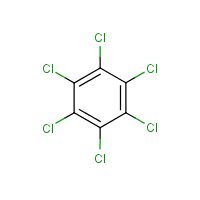Hexachlorobenzene
Agent Name
Hexachlorobenzene
Alternative Name
HCB
CAS Number
118-74-1
Formula
C6-Cl6
Major Category
Pesticides

Synonyms
HCB; AI 3.01719; Amatin; Anticarie; Benzene, hexachloro-; Bunt-cure; Bunt-no-more; CEKU C.B.; CO-OP Hexa; ENT-1719; Esaclorobenzene [Italian]; Granox; Granox NM; HCB; Hexa C.B.; Hexa CB; Hexachlorbenzol; Hexachlorbenzol [German]; Hexachlorobenzene; Julin's carbon chloride; NO Bunt; NO Bunt 40; NO Bunt 80; NO Bunt liquid; Pentachlorophenyl chloride; Perchlorobenzene; Phenyl perchloryl; Saatbeizfungizid [German]; Sanocid; Sanocide; Smut-Go; Snieciotox; Voronit C; Benzene, 1,2,3,4,5,6-hexachloro-; [ChemIDplus] UN2729
Category
Organochlorine Pesticides
Description
Colorless to white solid; [ICSC] White powder; [Aldrich MSDS]
Sources/Uses
Was used as a pesticide until 1965; it may be produced as a waste product from chloralkali and wood-preserving plants or as an emission from municipal incinerators; it can bioaccumulate in lichens, fish, marine animals, birds, and caribou; [ATSDR ToxFAQs] Used as a seed fungicide to prevent common and dwarf bunt on wheat; [EXTOXNET] "Hexachlorobenzene differs chemically and toxicologically from hexachlorocyclohexane, the gamma isomer of which (lindane) is still a widely-used insecticide." [EPA Pesticides] Used in organic synthesis; [Merck Index] Used to make rubber, electrodes, dyes, pentachlorophenol, and aromatic fluorocarbons; Also used as plasticizer for polyvinyl chloride, wood preservative, in military pyrotechnics, and to impregnate paper; [HSDB] Uses likely discontinued: as a wood preservative and in manufacture of munitions, aluminum (fluxing agent), graphite anodes, and rubber; Used as fungicidal seed treatment in some countries until 1985; Still produced in appreciable quantities as by-product in manufacture of chlorinated solvents and pesticides; [INCHEM HSG]
Comments
In Turkey between 1955-1958, about 4000 people developed a cutaneous porphyria syndrome six months after eating bread contaminated with hexachlorobenzene. [Ladou, p. 265] "No evidence of hepatic injury in humans as the result of environmental contamination." [Zimmerman, p. 414] May affect liver and nervous system causing impaired organ function and skin lesions; May be toxic to human reproduction, based on animal studies; [ICSC] The liver is the primary target organ of toxicity; Interferes with porphyrin metabolism which may lead to acquired porphyria cutanea tarda; Crosses the placenta and is excreted in breast milk; May cause skin, eye, nose, throat and lung irritation; No evidence of inhalation causing porphyria cutanea tarda or other adverse effects; Skin absorption not considered major route of exposure, although dermal absorption has been shown in studies of rats; [INCHEM PIM]
Restricted
Banned from use as a pesticide in the U.S. [EXTOXNET]
Reference Link #1
Biomedical References
Exposure Assessment
Skin Designation (ACGIH)
Yes
Bioaccumulates
Yes
TLV (ACGIH)
0.002 mg/m3
Vapor Pressure
1.8E-05 mm Hg
Lethal Concentration
LC50 (rat) = 3,600 mg/m3
Half Life
Half-life in rats and monkeys was measured at 3-4 months and 2 1/2 to 3 years, respectively. [EXTOXNET]
Adverse Effects
Hepatotoxin
Hepatoxic (a) from occupational exposure (secondary effect) or (b) in animal studies or in humans after ingestion
Reproductive Toxin
Yes
IARC Carcinogen
Possible (2b)
NTP Carcinogen
Anticipated human carcinogen
ACGIH Carcinogen
Confirmed Animal
Other Poison
Organochlorine
Diseases, Processes, and Activities Linked to This Agent
Diseases
Occupational diseases associated with exposure to this agent:
Processes
Industrial Processes with risk of exposure: